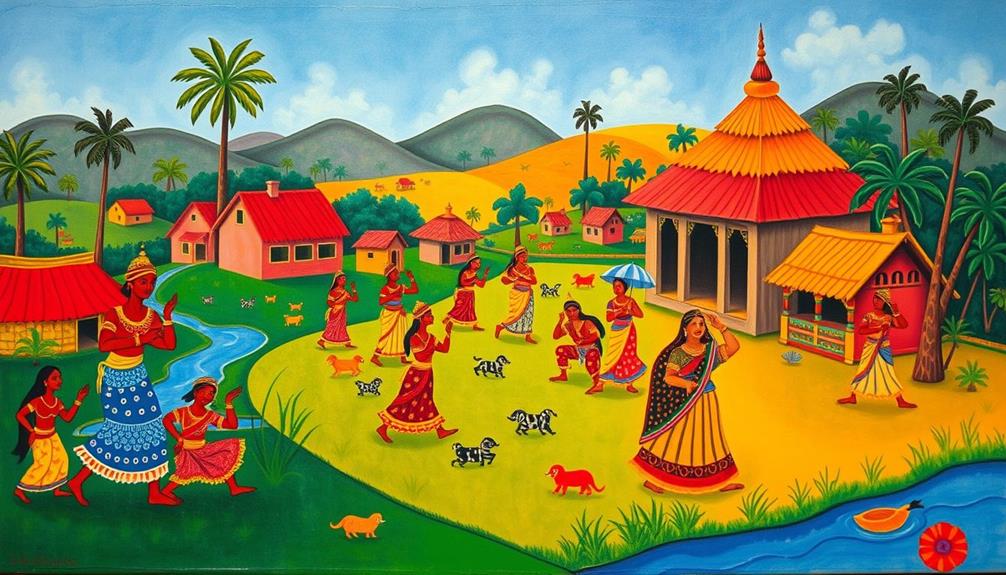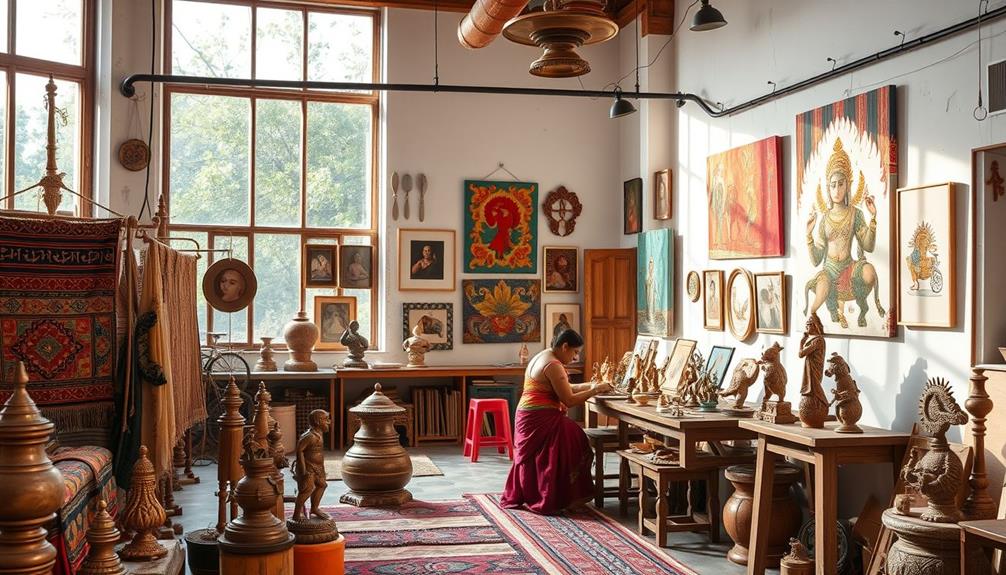The intersection of traditional and contemporary art in India creates a vibrant dialogue that celebrates cultural heritage while embracing modernity. You'll see artists merge traditional techniques like Warli and Madhubani with contemporary styles, producing works that resonate globally. This fusion not only reflects evolving identities but also revitalizes age-old practices, making them relevant today. Art galleries and online platforms play essential roles in promoting these hybrid creations, connecting emerging artists with wider audiences. If you explore further, you'll uncover the fascinating ways these artistic expressions continue to shape India's rich cultural landscape.
Key Takeaways
- Contemporary artists blend traditional Indian art forms with modern techniques, preserving cultural significance while redefining artistic expression.
- The fusion of styles like Warli and Madhubani enriches dialogues on cultural identity and contemporary social themes.
- Evolving brushwork and mixed media in modern art reflect diverse cultural narratives and individual creativity.
- Art galleries promote emerging artists, facilitating cultural exchange and showcasing innovative blends of traditional and contemporary art.
- Digital platforms have transformed the art market, making hybrid artworks accessible to a broader, younger audience.
Traditional Indian Art Forms
Traditional Indian art forms represent a vibrant tapestry woven from the influences of various cultures throughout history. They encompass a rich array of techniques and styles, from intricate miniature paintings to the expressive patterns of Warli and Madhubani. Each piece reflects India's diverse cultural heritage, showcasing vivid colors and spiritual themes that resonate deeply with viewers.
You'll find that these art forms often utilize natural materials like clay, wood, and stone, highlighting a strong community involvement in the creative process. In recent years, there's been a growing interest in how these traditional forms can intersect with modern practices, much like the exploration of art and culture seen in contemporary art movements.
The Bengal School of Painting played a pivotal role in bringing attention back to these traditional Indian art forms in the early 20th century. By merging indigenous techniques with modern themes, it inspired a generation of artists to explore their roots.
Today, contemporary artists increasingly draw upon this rich legacy, creating a fusion of traditional and modern elements that captivates a global audience. They breathe new life into Indian painting, ensuring that the stories and cultural significance of traditional art forms continue to thrive. By embracing these influences, they not only preserve the past but also push the boundaries of artistic expression in contemporary contexts.
Modern Painting Techniques
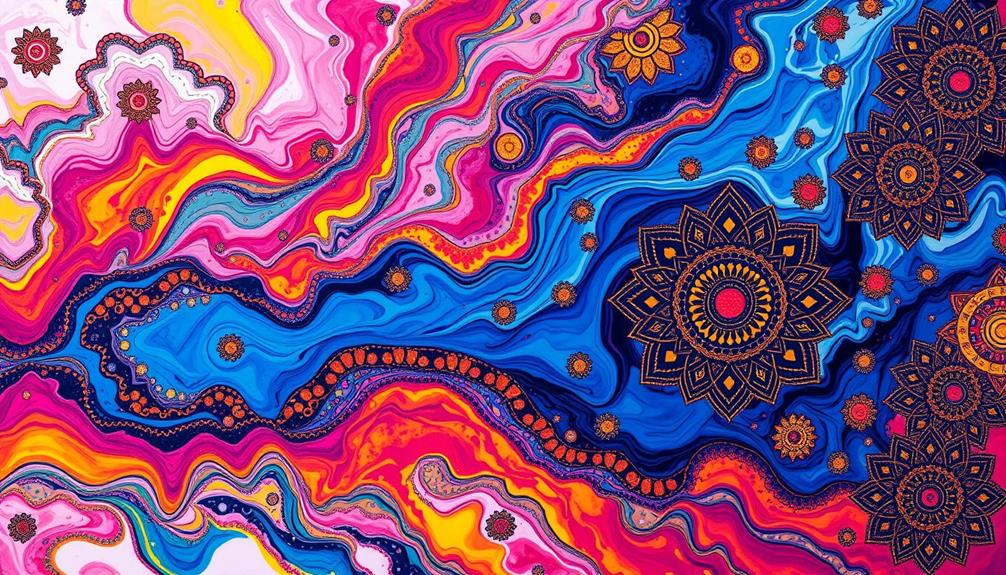
Modern painting techniques in India are all about evolving brushwork that reflects cultural identities. Influenced by a myriad of factors, artists often draw inspiration from influential orators and their powerful storytelling.
You'll notice how artists blend traditional methods with contemporary styles, creating pieces that resonate on multiple levels. This fusion not only showcases personal expression but also connects with broader social themes, making each artwork a dialogue between the past and present.
Evolving Brushwork Techniques
Brushwork techniques in contemporary Indian painting are undergoing a remarkable transformation, merging age-old practices with innovative methods. As you explore modern Indian art, you'll notice how artists are blending traditional and modern approaches to create unique artistic expressions.
Today, many painters are embracing a variety of tools, such as airbrushes and palette knives, in addition to traditional brushes. This evolution in brushwork allows for a broader range of textures and effects, enriching their contemporary art. In addition, artists often draw inspiration from the psychological impact of zodiac signs on self-perception, influencing their creative processes.
Moreover, artists often incorporate natural pigments and dyes rooted in traditional practices, fostering a connection between modern and historical art forms. You'll see how contemporary Indian painters frequently experiment with layering techniques and mixed media, combining classic methods with new-age materials like acrylics and digital tools.
This shift towards abstract and expressive styles encourages artists to depart from strict traditional techniques, enabling them to explore personal narratives and modern themes through dynamic brushwork.
The evolving brushwork techniques in modern Indian painting not only reflect individual creativity but also signify a vibrant dialogue between the past and present, enriching the artistic landscape of India.
Cultural Identity Expressions
In the vibrant world of contemporary Indian painting, artists are skillfully weaving together diverse techniques to articulate their cultural identities. Modern artists are increasingly blending traditional art forms, like Madhubani and Warli, with contemporary styles to convey complex narratives that reflect the ever-evolving cultural landscape of India.
This rich tapestry of expression mirrors the way herbalism combines ancient practices with modern understanding, as seen in learning resources for herbalism. For instance, Bharti Kher's use of bindis in her installations merges historical significance with modern aesthetics, inviting deeper engagement with both past and present.
Artists such as Jitish Kallat demonstrate how social and political themes can be juxtaposed with historical texts, creating powerful dialogues through contemporary Indian art. You'll find that techniques like acrylic pouring and digital art are becoming popular tools for modern artists, allowing them to reinterpret traditional aesthetics in innovative ways.
This fusion not only highlights their cultural identity but also resonates with a global audience.
Thanks to the growth of online platforms, these Indian artistic expressions now reach far beyond local boundaries, while still grounding themselves in their rich cultural roots. In this dynamic interplay, contemporary Indian art continues to celebrate and redefine what it means to express cultural identity today.
Fusion of Artistic Styles

The fusion of artistic styles in India creates a vibrant tapestry that captivates audiences worldwide. This unique blend of Traditional Indian Art and contemporary influences showcases the rich heritage and dynamic evolution of Indian culture.
You'll find that contemporary artists are innovatively merging ancient techniques with modern themes, producing works of art that speak to diverse audiences. This artistic dialogue parallels the way essential oils, such as essential oils for hair growth, are incorporated into modern wellness practices, enhancing both beauty and health.
- Bharti Kher's installation art, featuring bindis, exemplifies this fusion in "The Skin Speaks a Language Not Its Own."
- Jitish Kallat's "Covering Letter" juxtaposes Gandhi's historical letter with contemporary bone china, bridging past and present.
- Many artists are integrating styles like Madhubani and Warli paintings into contemporary narratives, enhancing their relevance today.
This artistic fusion not only highlights the dialogue between historical narratives and modern issues but also facilitates cultural exchange through exhibitions that showcase both forms.
It encourages a new generation of artists to reinterpret traditional art forms, ensuring that the essence of Indian culture continues to thrive and evolve. In this way, the fusion of artistic styles becomes a powerful medium for storytelling, connecting the past with the present in meaningful ways.
Cultural Significance of Art

Art holds immense cultural significance in India, reflecting a tapestry of historical influences and diverse belief systems. Traditional Indian art embodies a rich heritage shaped by periods like the Indus Valley civilization, Buddhism, Jainism, and Islamic art. These influences not only enrich the cultural landscape but also serve as a foundation for contemporary artistic expressions.
The integration of natural materials in decor mirrors the emphasis on authenticity seen in both traditional art forms and modern farmhouse aesthetics. As an artist, you might find that spiritual and religious themes prevalent in traditional works inspire your modern interpretations. This fusion of traditional techniques, such as miniature painting and Madhubani, with contemporary styles allows you to explore and express your cultural identity, connecting local narratives to global contexts.
Art galleries play an essential role in showcasing this unique blend of traditional and contemporary art, promoting the cultural significance of what you create. They facilitate cultural exchange and support emerging artists like yourself, ensuring that both traditional elements and modern themes coexist harmoniously.
The growing trend of incorporating traditional motifs into contemporary art underscores the importance of preserving your cultural legacy while embracing new techniques and ideas. This dynamic interplay not only enriches your work but also engages a broader audience in appreciating India's artistic heritage.
Role of Art Galleries
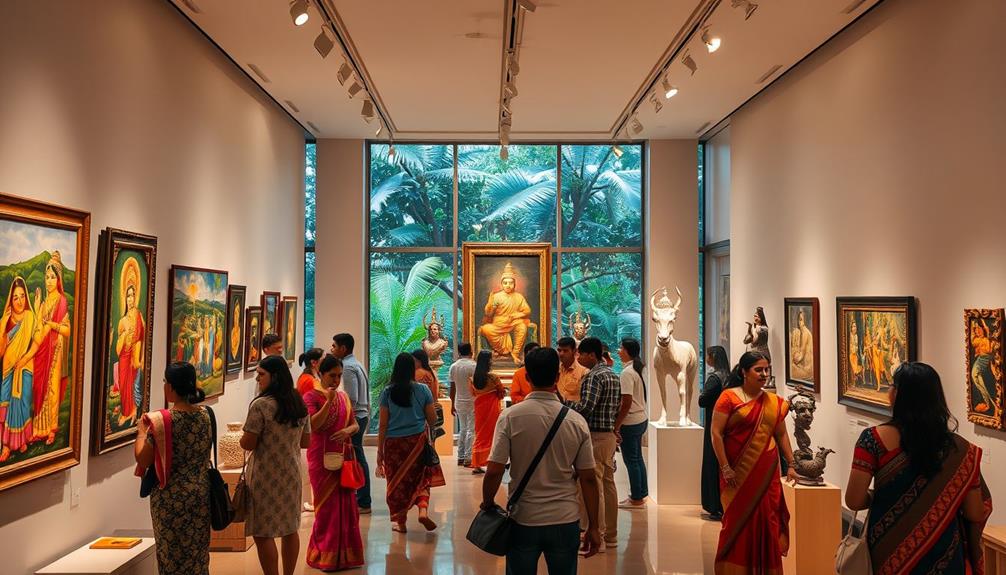
Art galleries in India are essential for promoting emerging artists and showcasing diverse art forms.
They also serve as community hubs that encourage collaboration and innovation, often incorporating team-based games during events to foster engagement.
They create opportunities for cultural exchange, connecting local talent with international audiences.
Promoting Emerging Artists
Showcasing emerging talent is essential for the vibrancy of India's art scene, and galleries play a pivotal role in this process. By promoting emerging artists, art galleries create platforms where new voices can be heard among established ones. This enhances the visibility and credibility of budding creators.
Additionally, just as tiny houses focus on optimizing space and energy, galleries can create efficient exhibition spaces that highlight the unique qualities of each artist's work, guaranteeing that every piece resonates with the audience. Incorporating energy-efficient practices in gallery operations may also appeal to a growing environmentally conscious collector base.
- Integrating traditional and contemporary Indian art forms
- Building valuable networks with collectors and critics
- Expanding reach through online art platforms
Galleries like Emami Art focus on blending contemporary practices with traditional art, empowering artists to explore their cultural heritage in new ways. They also facilitate connections between emerging artists and industry players, paving the way for career advancements.
Through curated exhibitions and events, these galleries not only spotlight fresh talent but also stimulate cultural dialogue within the global art community.
With the rise of online art galleries, emerging artists can now reach broader audiences, selling and promoting their works beyond local markets. This evolution in the art landscape guarantees that new talents are celebrated and supported, enriching the diverse tapestry of Indian art forms.
Cultural Exchange Initiatives
Galleries in India actively facilitate cultural exchange by bringing together traditional and contemporary art forms. They showcase the works of Indian artists, allowing for meaningful dialogue between diverse artistic practices. By promoting both emerging and established artists, these art galleries enhance visibility and appreciation of India's rich artistic heritage on a global scale.
Moreover, art galleries increasingly integrate technology into their exhibitions, fostering digital creativity that connects with younger audiences, which is crucial in today's evolving art landscape.
Exhibitions often blend various mediums, such as paintings and installation art, reflecting the dynamic nature of contemporary artistic expressions while honoring traditional techniques. This approach not only highlights the relevance of traditional art in today's context but also encourages innovation and experimentation among artists.
Many galleries support collaborative projects and cultural events that foster interaction between artists and audiences. This engagement deepens the understanding of India's multifaceted art scene, bridging the gap between traditional craftsmanship and modern art.
Additionally, by organizing workshops and public programs, art galleries guarantee the preservation and evolution of India's cultural legacy.
Ultimately, these cultural exchange initiatives play an essential role in enriching the art landscape, allowing for a vibrant interplay between traditional and contemporary art forms that resonates with diverse audiences.
Showcasing Diverse Art Forms
In India, numerous art venues serve as essential platforms that highlight a rich tapestry of artistic expressions, seamlessly blending traditional and contemporary forms. These galleries play a vital role in showcasing a diverse range of art, offering visitors a unique experience of Indian culture. Many galleries also emphasize eco-friendly materials in their displays, aligning with the growing trend of sustainable home decor.
- Experience traditional techniques like Madhubani and Warli.
- Discover modern interpretations that fuse history with contemporary themes.
- Support emerging artists as they find their voice in the art world.
Art galleries not only exhibit works that reflect India's rich heritage but also enhance the global visibility of Indian art through international collaborations. By inviting global artists and hosting diverse exhibitions, these venues foster a vibrant dialogue within the international art community.
Moreover, they support emerging talents by providing them with opportunities to showcase their work. This process contributes notably to the evolution of both traditional and contemporary art forms.
As millennials increasingly show interest in art collections, galleries adapt by including online sales platforms, making art more accessible. By doing so, they engage a broader audience and continue to promote the dynamic landscape of Indian art.
Online Art Marketplace

The digital revolution has transformed how art is bought and sold, leading to a booming online art marketplace in India. Platforms like IndianArtZone now feature over 10,000 artworks, showcasing a rich cultural blend of traditional and contemporary styles. This accessibility has attracted a new generation of collectors, particularly millennials, enthusiastic to discover affordable original paintings.
The pandemic propelled this shift, emphasizing the need for digital platforms to promote Indian artists. Now, art enthusiasts from the Indian diaspora and beyond can explore artworks that beautifully merge modern art themes with age-old techniques.
Here's a glimpse of what the online art marketplace offers:
| Category | Examples | Audience |
|---|---|---|
| Traditional Art | Madhubani, Warli | Art collectors |
| Contemporary Art | Abstract, Digital Art | Millennials |
| Global Access | International Shipping | Global art enthusiasts |
Online marketplaces support the preservation of traditional art forms while promoting contemporary expressions. By bridging the gap between cultures and styles, they create a vibrant community for artists and collectors alike.
Key Artists and Movements
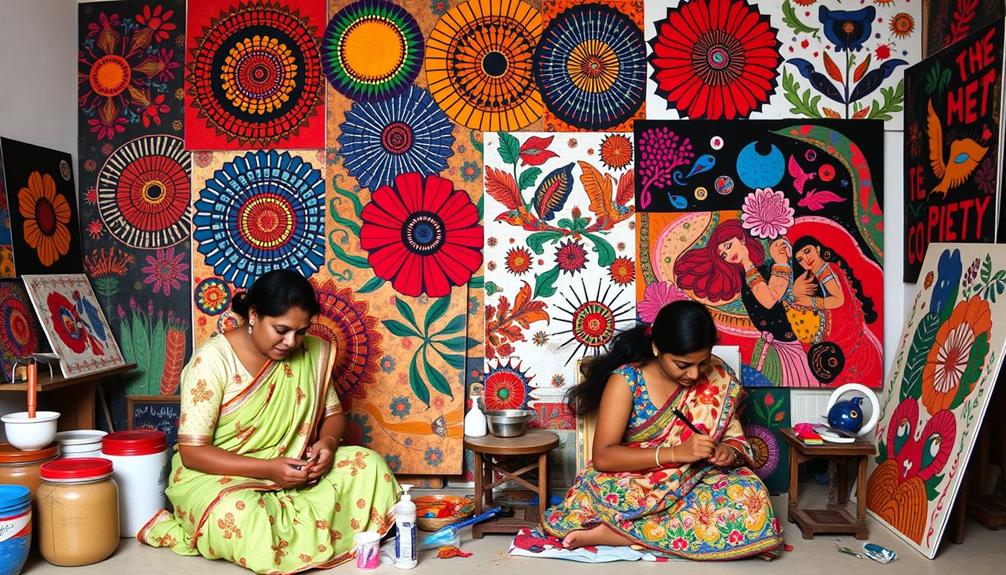
Key artists and movements have substantially shaped the landscape of Indian art, blending traditional roots with contemporary expressions. You'll find that these influences create a vibrant art scene, where old and new coexist harmoniously.
- Bengal School: Led by Abanindranath Tagore, this movement emphasized indigenous techniques, revitalizing traditional Indian art with modern sensibilities.
- Bombay Progressives: Founded in 1947 by artists like Souza and Husain, they rejected nationalist themes to embrace international modernism while incorporating indigenous motifs.
- Modern Pioneers: Amrita Shergill and K. G. Subramanyan pushed boundaries by merging traditional Indian aesthetics with Western influences, bridging urban and folk traditions.
Contemporary artists like Bharti Kher and Jitish Kallat continue this dialogue, showcasing the fusion of traditional motifs with modern installation and conceptual art.
Their work reflects an ongoing conversation between past and present, emphasizing the dynamic nature of Indian artistic expression.
As you explore these movements and artists, you'll see how they've not only enriched the art scene but also contributed to a broader understanding of cultural identity in India today.
Market Trends in Art
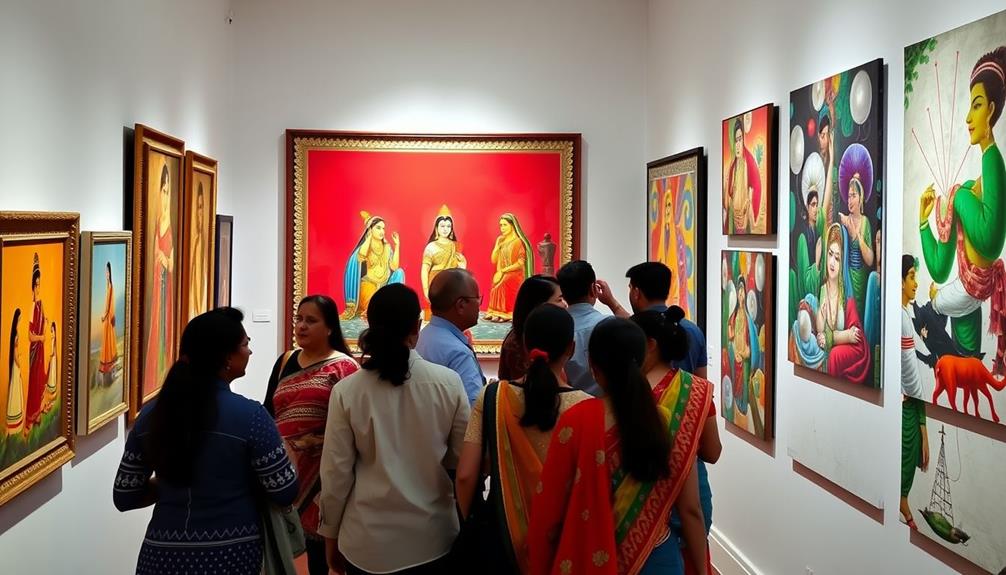
Art market trends are rapidly evolving, driven by a surge in online sales and changing collector demographics. You'll notice a significant increase in visibility and accessibility of both traditional and contemporary Indian art, especially after the pandemic.
As a collector, you might find millennials leading the charge in acquiring original artworks, which has sparked a rising demand for diverse styles that include rich and diverse traditional Indian forms.
New galleries are popping up across India, catering to a broader audience and promoting both established and emerging artists. This expansion reflects a blend of traditional practices and modern aesthetics.
Market trends indicate a growing appreciation for hybrid artworks. Artists use traditional techniques while fusing contemporary themes, resulting in unique pieces that resonate with various audiences.
The economic impact of the art market continues to shift, as collectors increasingly invest in traditional forms of art. They seek authenticity and a connection to cultural heritage in their acquisitions.
This trend emphasizes the importance of tradition while embracing the innovative spirit of contemporary expression, making the Indian art scene more vibrant and dynamic than ever before.
Contemporary Interpretations of Tradition

Reimagining the past, contemporary Indian artists breathe new life into traditional art forms, blending their rich cultural heritage with modern themes and techniques. You'll discover how this fusion revitalizes interest in practices once seen as static.
- Bharti Kher's installations merge bindis with contemporary art, exploring identity and cultural heritage.
- Jitish Kallat's "Covering Letter" juxtaposes a historical letter from Mahatma Gandhi with modern materials, illustrating the dialogue between past and present.
- Exhibitions showcasing these interpretations foster cultural exchange and deepen understanding of India's diverse heritage.
These contemporary Indian artists embrace traditional techniques, like Madhubani and Warli, and infuse them with vivid colors and innovative mediums, including installation art and digital formats.
By doing so, they communicate complex narratives that reflect modern Indian society. Raja Ravi Varma, known for his iconic depictions of mythology, inspires many in this movement, emphasizing the importance of tradition in contemporary contexts.
This blend not only preserves cultural practices but also reinvents them, making the past relevant today. You'll find that contemporary interpretations of tradition are reshaping the artistic landscape in India, ensuring that these vibrant art forms thrive for future generations.
Frequently Asked Questions
What Is the Contemporary Art Scene in India?
The contemporary art scene in India's vibrant and dynamic. You'll find artists exploring identity, politics, and globalization, often merging traditional techniques with modern concepts, creating innovative works that resonate both locally and globally.
What Is the Difference Between Traditional and Contemporary Art?
Traditional art focuses on historical techniques and collective themes, while contemporary art emphasizes individual expression and modern issues. You'll find traditional works rich in culture, whereas contemporary pieces often challenge cultural norms and explore new narratives.
How Are the Sacred and the Sensual Connected in Artistic Traditions in India?
In Indian artistic traditions, you'll find sacred themes intertwined with sensuality. Temple sculptures and classical dances celebrate divine love, while vibrant colors and patterns express deeper narratives, reflecting the unity of the spiritual and physical domains.
How Did Indian Art Change After the Indian Independence in 1947?
After 1947, Indian art exploded like a supernova, blending indigenous traditions with modern styles. You'll see artists embracing new techniques, exploring contemporary themes, and revitalizing ancient forms, creating a vibrant dialogue between past and present.
Conclusion
As you explore the dynamic intersection of traditional and contemporary art in India, it's fascinating to note that over 60% of Indian artists today blend traditional techniques with modern styles. This fusion not only preserves cultural heritage but also breathes new life into the art scene. With the rise of online marketplaces and innovative galleries, there's never been a better time to appreciate the rich tapestry of Indian art, where history and modernity beautifully coexist.

